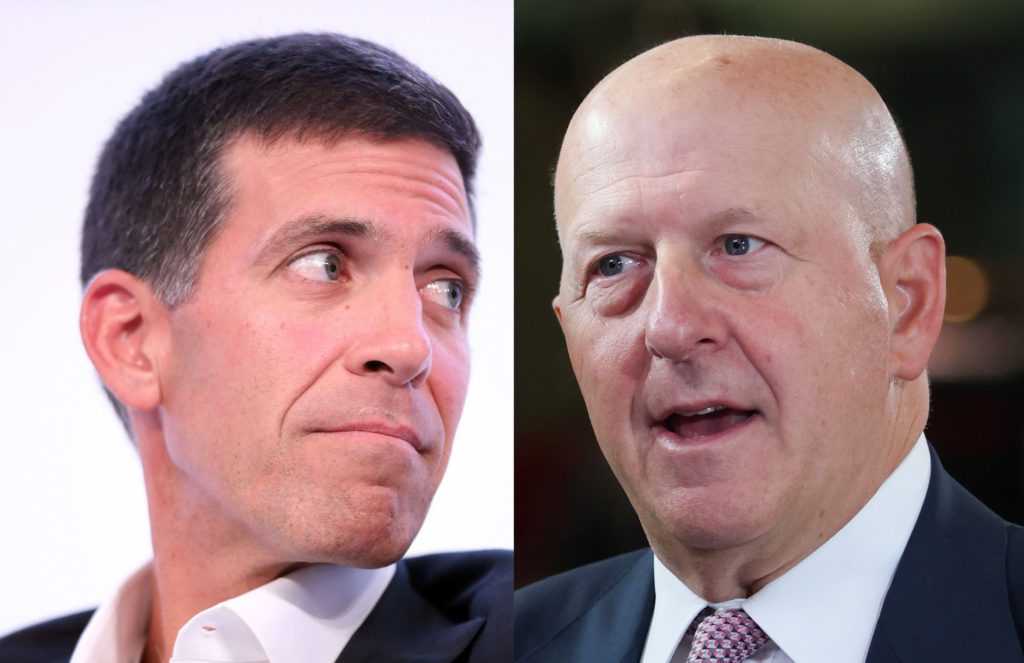Goldman Sachs Group Inc. is reconsidering how to launch a long-delayed product for the masses as senior executives wrestle with cost overruns.
(Bloomberg) — Goldman Sachs Group Inc. is reconsidering how to launch a long-delayed product for the masses as senior executives wrestle with cost overruns.
For more than a year, the firm’s consumer-banking arm has strained to ready online checking accounts that will let users set up direct deposits and pay their bills online — a key step toward the Wall Street titan’s goal of building a digital bank of the future.
But recently, Goldman leaders have been weighing whether to shelve the new account’s retail blitz until 2023, and instead open the platform in a more limited way, to private-wealth clients and some other existing customers, according to people with knowledge of the discussions. That would spare the firm from spending big on marketing in a year in which the online platform, known as Marcus, has seen losses accelerate. The company’s leaders have yet to make their decision.
David Solomon, who quickly embraced the nascent consumer unit as a key area of growth when he became chief executive officer in 2018, is now contending with its persistent cash burn as he tries to stay the course. Effectively a giant startup inside the bank, Marcus is set to post cumulative losses topping $4 billion since inception, according to the people, who asked not to be identified discussing internal business. That’s not including Goldman’s acquisition of installment-loans provider GreenSky Inc. in a deal initially valued at more than $2.2 billion last year at what turned out to be the peak of the market for fintech ventures.
Marcus, which already offers savings accounts, promised to add checking by mid-2021, but technical issues proved challenging. Now the product is nearing its unveiling at a daunting moment for the industry. Regulators in the Biden administration are scrutinizing fees. And some of the nation’s biggest retail banks have unfurled generous sign-up bonuses to attract new account holders.
Inside Goldman, conversations are focused on how to launch checking successfully while spending prudently. Solomon’s deputy, John Waldron, is personally overseeing Marcus’s expenses as part of an effort to put the unit back on course to contribute to earnings. As Solomon pushes forward, Waldron is trying to manage investor expectations.
Earlier this month, Credit Suisse Group AG analyst Susan Katzke wrote in a report that she was told by Goldman executives including Waldron that they still backed the growth initiatives but signaled a shift in focus — with more to wealth management and less to consumer banking. Katzke wrote that she welcomed that pivot.
A spokesman for New York-based Goldman declined to comment on the unit’s plans.
Checking Desire
Solomon has long made checking accounts a key part of Marcus’s strategy. When the bank started exploring the consumer market more than a half-decade ago, it considered a variety of products including credit cards, loans and investing offerings. But in the CEO’s view, the franchise had the best chances for success if it could establish itself as a customer’s primary financial-services provider.
Checking can offer a range of benefits to banks. The accounts create lasting — or “sticky” — relationships with customers by serving as the inbox for their paychecks and a hub for paying bills. The deposits are also a source of funding that lenders can use for loans and other businesses. And the accompanying debit cards generate a treasure trove of data on customers’ spending habits. For Goldman, all of that would help it become a one-stop shop for Americans’ everyday financial needs.
Yet profit margins for the accounts themselves can be thin. Overdraft fees and other charges for insufficient funds once provided more than half of the profits that banks reaped by offering mass-market checking. But lawmakers and regulators have taken a dim view of the billions of dollars in revenue that extracts.
Take the Consumer Financial Protection Bureau, which is already scrutinizing Goldman’s credit-card practices. In recent months, the agency asked consumers to weigh in on overdraft costs, typically penalties of roughly $30 that banks levy each time a consumer spends more than they have left in their accounts. A number of banks have promised to ease off.
“From the bankers’ perspective, the fee opportunities are diminishing,” said Sarah Grotta, a director at consultancy Mercator Advisory Group who focuses on financial products including debit accounts. “A lot of checking accounts actually, from a net income perspective, don’t make banks all that much money. But they’re a source of deposits that are valuable, and it’s a platform from which to create relationships for other types of products.”
In the early days, Solomon’s management team gave shareholders periodic updates on the business’s initial losses and even specified when investors could expect the venture to break even. But as deadlines slipped and expenses continued, the firm has shied away from providing new forecasts.
To make matters worse, Goldman readied its checking accounts just as the cost to acquire such customers soared. Rivals Citigroup Inc. and JPMorgan Chase & Co. have flooded mailboxes across the country, offering potential customers hundreds of dollars to open new accounts.
Lenders now spend a whopping $500 to acquire each new customer, according to the software provider FI Works. It found that even with those outlays, most banks still face the loss of 15% of their customers every year.
More stories like this are available on bloomberg.com
©2022 Bloomberg L.P.











